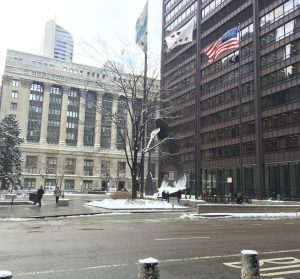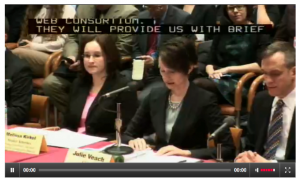Literally nothing was thrown away at the GreenTown Conference, held Oct. 15 at Columbia College Chicago, because all its waste was recycled or composted. But garbage was, in fact, on a lot of people’s minds there.
Because of one lecture at GreenTown, you may see changes to your neighborhood’s recycling program, or even the start of composting sponsored by your local government. City engineers from Chicago and at least seven suburbs attended a lecture by the man behind Toronto’s program for diverting refuse from landfills. GreenTown planners consider it one of the best in the world.
Geoff Rathbone, General Manager of Solid Waste Management with the City of Toronto, told the room of waste professionals and curious people that Toronto’s single-family homes and apartments now divert 65 percent of their household waste from landfills.
By comparison, Chicago diverts about 12 percent of its waste—via actions like recycling, reuse and composting—according to representatives of the Chicago Climate Action Plan. Enacted by city government a year ago, the plan’s goal is to reduce the city’s contribution to global climate change and brace for its impacts. It hopes to divert 90 percent of Chicago’s waste from landfills by 2020.
Lofty goals are achievable, Rathbone said, because his city’s residents started diverting that much waste “almost overnight.”
How did the word spread so quickly in Toronto? The city hired about 40 students to pair up and knock on doors. The students visited all 500,000 residential units in the city in a couple months’ time, and the rest is history.
The city’s composting operation is done in several stages, Rathbone said, and some steps have to be done outside the city because of the strong smell they release.
“Eighty percent of our efforts are directed at odor management,” Rathbone said.
But because the finished compost can be sold to generate additional revenue for the city, the operation only costs about $45 per household per year. The city had been spending $75 per household per year to put the same material—food and yard waste—into a landfill.
Toronto is on the verge of tapping even greater potential from its compost.
Rathbone said tests have shown that if the natural gas released during the composting process were put to use, it could power the entire fleet of more than 300 waste removal trucks. The plan may soon be implemented, he said.
In a question-and-answer session following the lecture, one woman said she had worked at a Chicago restaurant and witnessed recyclable waste continually being thrown in the garbage.
“The majority of restaurants and bars in Chicago do not recycle at all,” she said. “It’s frustrating.”
Rathbone appeared to sympathize, saying that restaurants under 5,000 square feet are eligible for the Toronto’s free recycling program.
The GreenTown conference was hosted by Columbia College Chicago as an outgrowth of its campus-wide Critical Encounters theme last year, entitled Human / Nature.
—
Toronto’s three big secrets to a successful waste-diversion program:
• Creating logical economic incentives, such as charging people by the volume of garbage they can throw away and providing composting and recycling removal for free.
• Providing free bins to families who subscribe to the city’s waste diversion/garbage removal service. (A set of bins cost the city $25, while a garbage subscription is $200-$400 a year, depending on the size of garbage removal requested.)
• Allowing people to use regular plastic shopping bags as liners for compost bins.
• Limiting garbage pickup to every other week. (Compost is picked up weekly.)
-Credit: Geoff Rathbone, Solid Waste Management Services, City of Toronto
















Be First to Comment